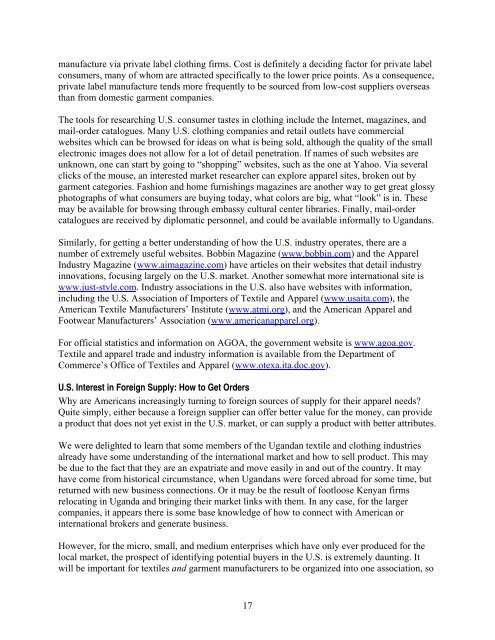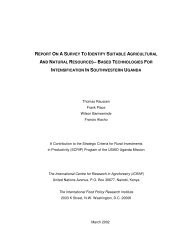Create successful ePaper yourself
Turn your PDF publications into a flip-book with our unique Google optimized e-Paper software.
manufacture via private label clothing firms. Cost is definitely a deciding factor for private label<br />
consumers, many of whom are attracted specifically to the lower price points. As a consequence,<br />
private label manufacture tends more frequently to be sourced from low-cost suppliers overseas<br />
than from domestic garment companies.<br />
The tools for researching U.S. consumer tastes in clothing include the Internet, magazines, and<br />
mail-order catalogues. Many U.S. clothing companies and retail outlets have commercial<br />
websites which can be browsed for ideas on what is being sold, although the quality of the small<br />
electronic images does not allow for a lot of detail penetration. If names of such websites are<br />
unknown, one can start by going to “shopping” websites, such as the one at Yahoo. Via several<br />
clicks of the mouse, an interested market researcher can explore apparel sites, broken out by<br />
garment categories. Fashion and home furnishings magazines are another way to get great glossy<br />
photographs of what consumers are buying today, what colors are big, what “look” is in. These<br />
may be available for browsing through embassy cultural center libraries. Finally, mail-order<br />
catalogues are received by diplomatic personnel, and could be available informally to Ugandans.<br />
Similarly, for getting a better understanding of how the U.S. industry operates, there are a<br />
number of extremely useful websites. Bobbin Magazine (www.bobbin.com) and the Apparel<br />
Industry Magazine (www.aimagazine.com) have articles on their websites that detail industry<br />
innovations, focusing largely on the U.S. market. Another somewhat more international site is<br />
www.just-style.com. Industry associations in the U.S. also have websites with information,<br />
including the U.S. Association of Importers of Textile and Apparel (www.usaita.com), the<br />
American Textile Manufacturers’ Institute (www.atmi.org), and the American Apparel and<br />
Footwear Manufacturers’ Association (www.americanapparel.org).<br />
For official statistics and information on AGOA, the government website is www.agoa.gov.<br />
Textile and apparel trade and industry information is available from the Department of<br />
Commerce’s Office of Textiles and Apparel (www.otexa.ita.doc.gov).<br />
U.S. Interest in Foreign Supply: How to Get Orders<br />
Why are Americans increasingly turning to foreign sources of supply for their apparel needs?<br />
Quite simply, either because a foreign supplier can offer better value for the money, can provide<br />
a product that does not yet exist in the U.S. market, or can supply a product with better attributes.<br />
We were delighted to learn that some members of the Ugandan textile and clothing industries<br />
already have some understanding of the international market and how to sell product. This may<br />
be due to the fact that they are an expatriate and move easily in and out of the country. It may<br />
have come from historical circumstance, when Ugandans were forced abroad for some time, but<br />
returned with new business connections. Or it may be the result of footloose Kenyan firms<br />
relocating in Uganda and bringing their market links with them. In any case, for the larger<br />
companies, it appears there is some base knowledge of how to connect with American or<br />
international brokers and generate business.<br />
However, for the micro, small, and medium enterprises which have only ever produced for the<br />
local market, the prospect of identifying potential buyers in the U.S. is extremely daunting. It<br />
will be important for textiles and garment manufacturers to be organized into one association, so<br />
17
















